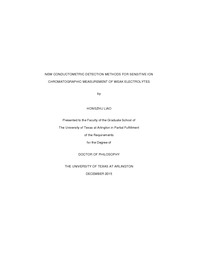
ATTENTION: The works hosted here are being migrated to a new repository that will consolidate resources, improve discoverability, and better show UTA's research impact on the global community. We will update authors as the migration progresses. Please see MavMatrix for more information.
Show simple item record
| dc.contributor.advisor | Dasgupta, Purnendu K. | |
| dc.creator | Liao, Hongzhu | |
| dc.date.accessioned | 2016-01-26T23:59:14Z | |
| dc.date.available | 2016-01-26T23:59:14Z | |
| dc.date.created | 2015-12 | |
| dc.date.issued | 2015-11-24 | |
| dc.date.submitted | December 2015 | |
| dc.identifier.uri | http://hdl.handle.net/10106/25470 | |
| dc.description.abstract | Since Suppressed conductometric anion chromatography (SCAC) was proposed in the mid-1970s, SCAC has become a widely used tool for the determination of anion species in aqueous samples. Its application ranges from trace analysis in semiconductor manufacture to pharmaceutical analysis. This dissertation primarily focuses on three different projects on the conductometric determination of weak acids. Other work carried out during the same period both involved SCAC for the determination of anion composition of açaí Extracts and on the unusual ion exchange behavior of myo‐inositol phosphates.
SCAC responds poorly and nonlinearly to weak acids, because they only ionize partially and the degree of ionization change as a function of pKa and concentration. Various efforts to improve conductometric detection of weak acids have been proposed. The best results have come from the introduction from a small constant amount of base after the suppressed conductometric detection (D1). The acid form of analyte HA can react with the equivalent base solution to produce the corresponding salt and the conductivity is measured again (D2). This second signal arises from the difference of the conductance of A- and OH- as the overall process is HA + OH- A- +H2O.
The use of a readily available commercial ICS-5000 IC system that contains two independently operable ion chromatographs provided facile implementation of such a scheme. SCAC was carried out in the analytical channel to separate different anions. After D1, LiOH generated by a capillary scale electrodialytic generator was introduced into the main stream by different mixers designed and built in-house, including a back-flow tee mixer (BT), an end-blocked membrane tee mixer (EMT), and a tubular membrane mixer (TM). Based on its mixing efficiency and small dispersion, the BT design was found to be the best to perform sensitive determination of weak acids at D2.
Using the same principle of reacting HA with OH-, a volatile analyte transfer device (VATD) of annular tubular design was fabricated to assist the transfer and enrichment of volatile weak acids. Volatile weak acids can transfer across a gas permeable membrane from the outer annular channel of VATD to the central channel. As this scheme is dilutionless and does not involve mixing of two liquids, the baseline noise at D2 reduced ≥100x, compared with previous efforts, resulting in a proportionate improvement in the limits of detection. The VATD is a robust low-noise device providing highly sensitive conductometric detection of volatile weak acids like sulfide and cyanide.
The third project provided complementarity to the second one. Because the majority of weak acids are not volatile, this time a permeative amine introduction device (PAID) was used to introduce a volatile base into the effluent weak acid stream. Diethylamine was chosen as the amine source due to its low pKb value (3.0) and high vapor pressure. The eluites were thus detected against a low diethylammonium hydroxide background (5-31 S/cm) as negative peaks. The PAID as described here is a robust low-noise design to allow sensitive conductometric detection of weak acids. | |
| dc.format.mimetype | application/pdf | |
| dc.language.iso | en_US | |
| dc.subject | Ion chromatography | |
| dc.subject | Weak acids | |
| dc.subject | Conductometric detection | |
| dc.subject | Silicate | |
| dc.subject | Cyanide | |
| dc.subject | Sulfide | |
| dc.subject | Arsenite | |
| dc.title | New conductometric detection methods for sensitive ion chromatographic measurement of weak electrolytes | |
| dc.type | Thesis | |
| dc.date.updated | 2016-01-26T23:59:14Z | |
| thesis.degree.department | Chemistry and Biochemistry | |
| thesis.degree.grantor | The University of Texas at Arlington | |
| thesis.degree.level | Doctoral | |
| thesis.degree.name | Doctor of Philosophy in Chemistry | |
| dc.type.material | text | |
Files in this item
- Name:
- LIAO-DISSERTATION-2015.pdf
- Size:
- 9.253Mb
- Format:
- PDF
This item appears in the following Collection(s)
Show simple item record


